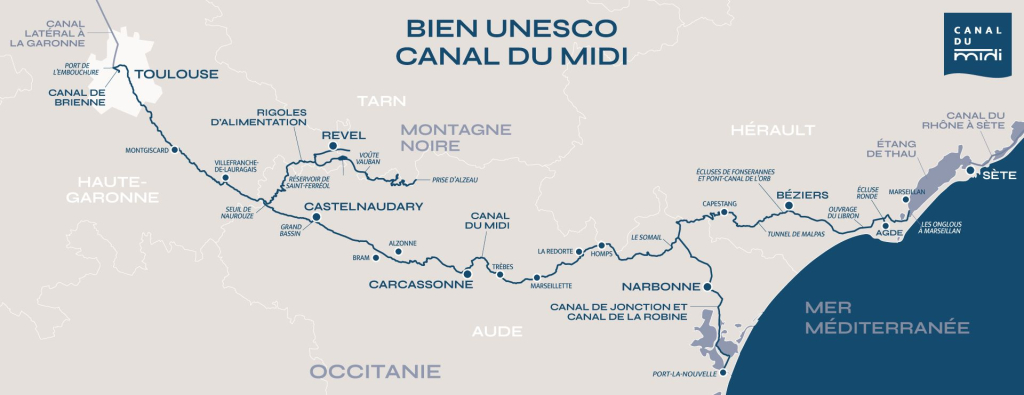
The Canal du Midi, a masterpiece with UNESCO World Heritage status
There's no doubt about it, the Canal du Midi is a masterpiece in hydraulics. There are countless engineering structures dotted along the route, ingenious constructions that were most definitely ahead of their time in terms of technical design.
The recognition of the canal as a UNESCO World Heritage Site is proof that it is an outstanding creation. The engineering structures and landscapes make this a priceless treasure that must be preserved and passed on to future generations.
A unique masterpiece of civil engineering
With its 360 kilometres (including the supply channels and side canals) and 328 engineering structures (locks, aqueducs, bridges, weirs, tunnels, etc.) there's no doubt about it, the Canal du Midi, built between 1667 and 1694, is one of the most extraordinary creations of civil engineering of modern times! This creation paved the way for the industrial revolution.
The Canal du Midi is the first section of the Canal des Deux Mers which provides a link between the Mediterranean and the Atlantic. This unique waterway is a living testimony to art and the creativity of the designers who were chosen by Louis XIV himself. Thanks to their ingenuity and technical expertise, they managed to overcome the challenges faced in terms of geography and hydrography to bring the age-old dream of linking the two seas true.
The technical and cultural achievements of the Canal du Midi made a significant mark on modern times and were a source of inspiration for the creation of inland waterway networks in industrialised countries across Europe and in North America.
Recognition as a UNESCO World Heritage Site
Scope of the Canal du Midi UNESCO site
On 7 December 1996, UNESCO added the Canal du Midi to the prestigious list of World Heritage Sites. This was when the international community recognised the canal as a creation of 'outstanding universal value'.
Being added to the list of World Heritage Sites also means that it is now necessary to preserve the waterway, increase awareness and pass it on to future generations.
The classification covers the entire canal, namely:
- the Canal du Midi itself, from Toulouse to Thau lagoon (240 km)
- the Canal de Jonction and Canal de la Robine that link the Canal du Midi to Port La Nouvelle (36.5 km)
- the water supply system in the Montagne Noire region, that supplies water to the Canal du Midi at the Seuil de Naurouze (76 km)
- the Canal de Brienne in Toulouse that provides the link to the Garonne (1.5 km)
- a section of the Hérault river in Agde (0.5 km)
Did you know?
The UNESCO status also covers a buffer zone around the canal, including all the towns and villages in the 'wet zone'.
'Outstanding universal value'
What exactly does 'outstanding universal value' mean?
For so-called cultural assets (as opposed to natural assets), UNESCO has defined a set of six criteria to determine the value of an asset. The Canal du Midi satisfies 4 out of the 6 selection criteria, which is remarkable. There are not many UNESCO sites that satisfy 4 of the selection criteria. They are as follows:
1: to represent a masterpiece of human creative genius.
2: to exhibit an important interchange of human values on developments in architecture or technology, monumental arts, town-planning or landscape design.
4: to be an outstanding example of a type of building, architectural or technological ensemble or landscape which illustrates (a) significant stage(s) in human history.
5: to be an outstanding example of a traditional human settlement, land-use, or sea-use which is representative of a culture (or cultures), or human interaction with the environment.
A site to preserve and showcase
Protect the Canal du Midi world heritage
When France signed the Convention Concerning the Protection of the World Cultural and Natural Heritage in 1972, it made a promise in front of the international community to ensure its World Heritage Sites were protected and enhanced, to safeguard Outstanding Universal Value, and to pass on this heritage to future generations, untouched.
But adding an asset to the list of world heritage sites does not mean it is protected legally. Therefore, to ensure the protection of the Canal du Midi in legal terms, the asset and its landscapes are classified as individual sites, in accordance with the law of 2 May 1930. Any modification must be authorised by the State.
Forty-six of the engineering structures on the Canal du Midi are also listed or classified as Historic Monuments, in accordance with the law of 31 December 1913.
Included in these heritage protection initiatives, there are also a number of areas that are subject to archaeological requirements along the canal route.
The Canal du Midi and its landscapes classified by the French State
On a national level, the Canal du Midi and its supply system were classified between 1996 and 2001. This national recognition is based on 3 requirements:
- the historic nature (masterpiece of the late 17th century),
- the scientific nature (a technological achievement) and
- the picturesque nature.
In 2017, it was time for the Canal du Midi landscapes to be recognised for their picturesque value. The landscapes around the canal have been shaped by centuries of human activity and play a key role in the quality of the structure.
In 2022, the channels of the Canal du Midi supply system were added to this classification.
To find out more: Classified sites of the Canal du Midi | DREAL Occitanie
These classifications give the French State responsibility of the assets before the international community, and provide the regulatory means to take control of development projects on the banks of the Canal du Midi. The goal is to ensure the assets remain on the list of world heritage sites over the long term and ensure this outstanding heritage is passed on to future generations.




